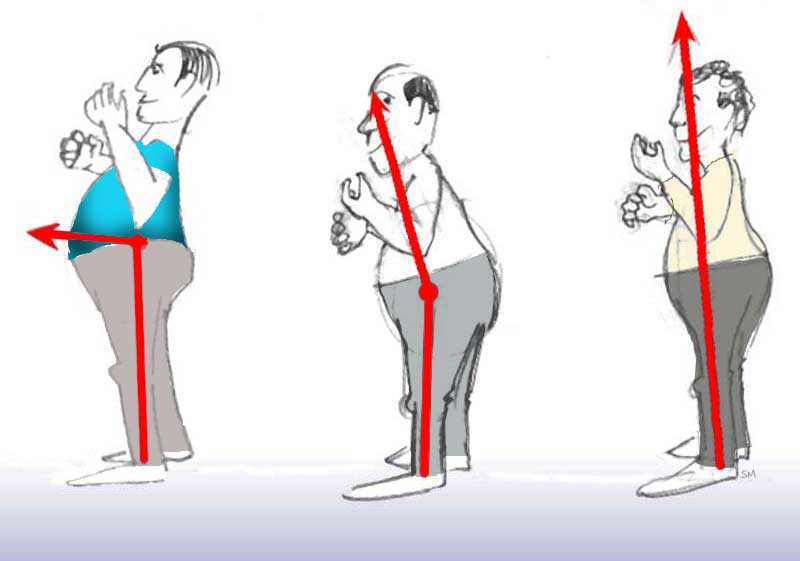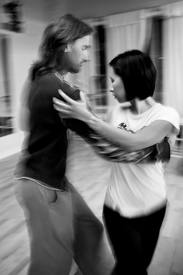Some practice advice
Surprisingly, there doesn't seem to be much easily-available information (I tried googling "tango practice advice" and one of the top entries was one of my previous pages. Most of the others were simply adverts!).
So here's my contribution...
So what is a Practice?
What it's not
When we think of "practice", a lot of time we think of ballroom couples, endlessly rehearsing the same complex sequence of movements to the same music, in order to perform / achieve some type of medal. And to be fair, probably "practice" is maybe not a great word - it can imply a certain amount of repetitive activity. But my response to that image is simple.
No. No, no, no.
Let me rephrase that.

Practice sessions are not "rehearsals", they're not (usually) based on sequences, they're not (usually) done to a single track, and they're definitely not about trying to memorise movements for a performance.
That out of the way...
What it is
To me, a practice session is a way to examine, review, and work on your own dancing technique, with the aim of improving, at a pace that works for you.
There are three possible practice scenarios:
- Solo
- With a partner
- In a group
We'll look at each one, in turn.
Practicing Solo
There's a lot of possible solo practice exercises you can perform - you just need some space at home to do them. It also helps to have a mirror to check your posture.
This section focusses on the "mechanics" of exercises you can do with tango.
Balance

Standing: stand with your feet together (this is a good time to work on your posture also.) Move your weight forwards and backwards. Learn to feel the place where your weight is over the balls of your feet. Be sure to keep your heels on the floor. You could try this exercise with shoes having different heel heights, too.
Weight Changes: without moving your feet - Lengthen the unweighted leg into the floor to do the weight change. The weight should go to the inside of the weighted foot. Again, neither foot moves anywhere.
Walking (for the woman)
A "walking checklist" for ladies:
- Moving leg and foot backwards from the hip, extending your back leg to be straight at the end of the movement.
- When you move backwards find the floor with your big toe first.
- Keep your torso at the same forward angle as when you were standing still.
- Both of your feet should be together and on the floor after each step, but only one foot has all of your weight.
- Be sure to practice taking one step at a time, and collecting.
Dissociation
Turn torso to left and right.
Walk straight (backwards or forwards). Turn torso to the left while continuing to walk straight . Return torso to center. Turn torso to the right while continuing to walk straight backwards.
Ochos
Start with both hands touching the wall about shoulder height - keep your arms straight, and do the whole exercise without varying your distance from the wall or the pressure on your hands.
Following on from the dissociation exercise, practice pivotting on the weight-bearing foot, in either direction, whilst keeping your upper body facing the wall.
Once you've done that, you can then practice pivot-and-step combinations, for forwards and back ochos.
- Back ocho: pivot, then step back on the outside foot. Weight goes onto the inside border of the foot that went behind. "Collect" by moving the now unweighted foot to assume a normal stance.
- Forward ocho: same exercise, but step forward on the inside foot.
Try practicing either, but instead of the weight change, and step, control how much weight you put onto the foot you are stepping on, then reverse the motion.
Practicing with a partner
(This section will not focus on mechanice, but on process - that is, how to make whatever you practice as effective as possible.)
It's also a good idea to practice regularly with a partner.

Now, there's a whole debate to be had - there's probably a whole book to be written - about the difficulties of finding a "good" practice partner (someone at roughly your level of experience and ability), and the logistics skills required to get you both regularly together in a dance space to practice in. There's also the question of avoiding the blame game, of being able to give each other constructive advice, and of working with someone who has the same aims as you - there's no point in having a partner who only wants to work on her boleos, if you only want to work on your walk, for example. It's all extremely difficult to set up and maintain.
Frankly, it'd be far simpler to have an affair with someone than to practice dancing with them.
But let's assume you've got a good partner, you've got the location, you've got a regular time, and you're now looking for things to do with them. So here's some possible tips.
Video yourselves

Video yourselves, right at the start to establish a "baseline", and regularly during each practice session from then on. Also, take the time to review the videos yourselves - don't just let them gather virtual dust on a memory stick. Sites such as Facebook are very good for sharing videos (you can share them just with your partner, of course, you don't have to broadcast them to the world).
It's important to remember that in these videos, you're looking for mistakes. They're not performances, they're learning aids - if you're doing everything right, there's no point in videoing yourselves. So don't be put off by the fact that you "don't look good". That's precisely the point of the exercise.
Have a Plan

It's not really that effective to just turn up and work on stuff - unless you're very experienced, you simply won't be able to improvise a practice session. So plan ahead. The plan doesn't have to be complex - something like "practice walking to Di Sarli" or "Work on ochos" is detailed enough. If you have that aim for each session, then it saves you time and gives you both a focus for the session.
It's also not a bad idea to have a more long-range plan, a "theme" covering multiple sessions (for example, "develop musicality in close embrace" or similar).
Keep it simple

Lastly, keep it simple. don't try and work on multiple things at once. Have a single topic per session, and focus on that. If you're planning to work on ochos, then just work on ochos. Don't suddenly get distracted by a cool volcada movement.
In a related point, don't try to rush things either. As you've probably realised, we all learn and improve at different paces. It's not a race, the learning process is meant to be enjoyable and rewarding in itself. So relaaaaaax.
Group Practice ("Practica")
Finally, we come to group practice sessions - "Practica" sessions.

Firstly, it seems that most "practicas", at least in the London area, are not group practice sessions; they're either "sloppy milongas" (dancing socially in a hall to a playlist, with no trimmings), or "disguised class nights" (a class-in-all-but-name, followed by a milonga-in-all-but-name).
To me, a group practica is one where members of the group work together, in a communal (almost hippy-like) manner, on specific topics decided by members of the group. Group members will dance with different people (rather than stay in couples), will feel free to critique other members', and will generally contribute to the flow of knowledge - everyone helping everyone else, ideally.
There are some great benefits from such a setup. To take just a few:
- There's always someone available to video or provide objective critique
- You can work on group-based exercises (for example, floorcraft in a small area)
- You gain experience of dancing with others (typically exposing the fact that, no, it's not your partner's fault, it was you doing it wrong all along...)
- You can test theories or improvements on different partners.
- Costs of hall hire are shared and therefore reduced.
Of course, like all these things, it needs effort from the group to organise it, to maintain it, and to use it equally. It only really works if the members of the group are enthusiastic and consistently committed to the group. And such commitment is rare.
David Bailey, 10th April 2012